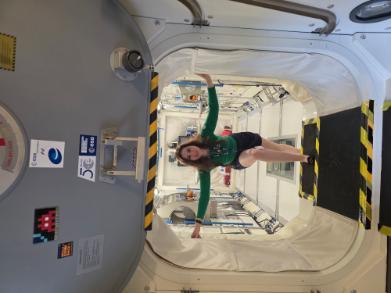Marialina Tsinidis
My name is Marialina Tsinidis, I am an undergraduate student at the University of Glasgow, studying Geoscience at the School of Geographical and Earth Sciences. I am currently an intern at the European Space Agency, specifically at the European Astronaut Center (EAC), which is where European and international astronauts train before a space mission.
The research at EAC is focused on astronaut training as well as human and robotic exploration. As part of the astronaut training, there is an exact replica of the International Station (ISS), where the astronauts to learn how to navigate inside the ISS and operate the instruments. Additionally, the Neutral Buoyancy Facility - a 10m deep pool, is used for diving with the space suit, while the ISS can be submerged to simulate the Extra Vehicular Activities.
In support of the Human and Robotic Exploration, the LUNA facility is composed of moon-like regolith and is used for astronaut training for lunar missions and rover testing. Adjacent to LUNA, there is a lunar habitat used for isolation studies and for lunar mission simulations. Beyond training, the Crew Medical Support Office includes the space medicine team for monitoring the astronauts before, during and after the mission. Following each mission, the astronauts are monitored for a certain period of time and undergo medical examinations and physiotherapy.
The ISS operation control center, provides constant communication with the ISS in order to support astronauts during experiments and facilitates communication between the astronauts and the medical crew. The location of the facility is in the campus of the German Aerospace Center (DLR) which has the Institute of Aerospace Medicine for any medical testing required and the military airport for the direct return of the astronauts.
I am working at the Caves and Pangaea team, which is a training course that aims to provide astronauts with survival skills (surviving in caves with limited access to supplies) and practical skills in geology (Pangaea - Planetary ANalogue Geological and Astrobiological Exercise for Astronauts). More specifically, through these expeditions, the astronauts train in geological transverses, astrobiology, mineral identification, spectroscopy and sample selection. The training takes place in planetary analoig environment, that have similar rock types as the Moon, such as Lofoten, Norway or Lanzarote, Spain. For instance, in Lofoten, the main composition is anorthosite which can be also found in the Moon highlands.
ESA - CAVES and Pangaea
More specifically, I am working on the Development of Analytical Toolset for recognition of Planetary Materials and Validation of Spectra Classification Methods. It is a mineralogical database which contains all the minerals found in Moon, Mars and meteorites, their chemical composition, and spectral measurements using multiple portable spectrometers that the astronauts carry during transverses.
It is a truly unique working and learning environment. I am surrounded by exceptional scientists with many years of career dedicated to astronaut support and space missions. Working with researchers that share the same passion, motivates me to overcome any challenges and perform my best. The astronauts are very inspiring people, risk takers with immense knowledge and expertise, their life-style is completely adjusted to their challenging career and at the same time always smiling, very approachable and friendly, they are role-models. I have learned new skills and I had the chance to apply theoretical knowledge in a hands-on project, in space related expeditions. Moreover, the work I am doing is directly applied to the team, which makes me feel I can contribute to the training of the astronauts. Through this experience, I have been given the opportunity to apply the knowledge from my course at the University of Glasgow, in supporting the astronaut training for space missions and I have gained significant knowledge and skills in a large scale project, where my input is directly used and applied. Seeing the progress from scratch, until the completion of a project is the most rewarding part. Thanks to this experience, I realized that my passion for space is shared by same minded people and the people is what makes this job so enjoyable.
I would like to thank from the bottom of my heart the School of Geographical and Earth Sciences, particularly Dr. Hannah Mathers, Dr. Luke Daly and prof. Martin Lee, for providing me with planetary science and spectroscopy knowledge, practical skills, and field work experience each of which has been integral to my internship.


